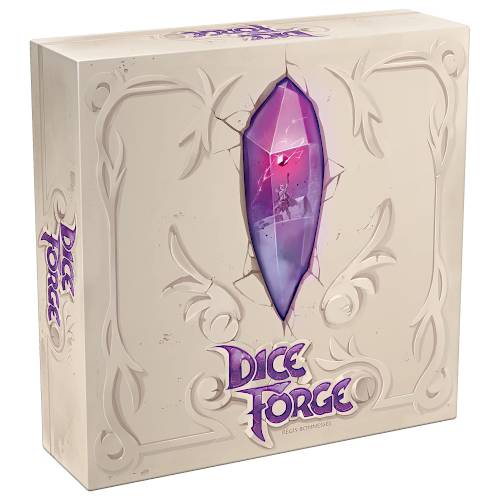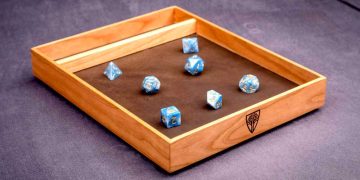As a hobby board gamer, I love all kinds of board games with all kinds of mechanics—but there's something truly special about dice games.
The cool feel of plastic in hand, the satisfying clack-clack-clack as you shake them up, the tense moments of bated breath as you toss them and hope for the results you need. It's just so fun.
Dice games may involve more luck than other kinds of board games, but that's part of their charm. Managing risk and playing the odds are skills unto themselves, and it's great when a little bit of luck pays off.
Here are our picks for the best dice games across a broad range of complexities to consider for your own board game collection.
13. Qwixx

Do you like classic Yahtzee? Then you'll love Qwixx! It's a roll-and-write game where everyone plays their turns simultaneously.
Players have score cards with the numbers 2 to 12 in each of four colors: red, yellow, green, blue. Each round, a set of six shared dice are thrown: two white dice plus one die of each color.
The dice determine which boxes can be marked off on score cards, but here's the twist: once a number is marked off for a color, you can't mark off smaller numbers of that color in future rounds.
And if you can't mark off any number in a round, you get a penalty. Once someone has accrued four penalties, the game ends. It's a fast family game that's easy to learn and surprisingly addictive to play!
Note: The score cards are one-time use, so you will eventually need to order replacement score cards if you play often.
12. Zombie Dice: Horde Edition

Few board games are lighter and simpler than Zombie Dice. In this game, players take turns rolling three custom dice with unique icons on them: Brains, Footsteps, and Shotguns.
For every Footstep, you can reroll that particular die. For every Brain, you earn one point. For every Shotgun, nothing happens... yet.
When you finish rolling, you can choose to score what you rolled—or grab an additional three dice and keep rolling. Rinse and repeat.
The catch? If you ever roll three Shotguns, you lose all the points you would've earned from Brains on that turn.
Zombie Dice is a game about pushing your luck and rolling as many Brains as you can, but managing your risk and knowing when to stop so you can score the Brains you've rolled.
11. Can't Stop

Can't Stop is a classic dice game where players take turns rolling dice to try to get three of their pieces across the board before everyone else.
On a turn, players roll four normal dice and divide them into pairs (e.g. rolling 1 3 5 6 could be assigned as 1+6 and 3+5). The board has pathways for each potential result (i.e. 2, 3, 4, 5...) with shorter paths for less likely results (i.e. 2 is much shorter than 7).
The catch? Once a piece is assigned to a path, it can't be switched to another path—and if you ever roll in a way where no combination of results will move your pieces, you lose all progress from that turn.
Can't Stop is a push-your-luck game much like Zombie Dice, but it has a little more substance and a longer play time.
10. Bang! The Dice Game

The original Bang! card game had some good ideas, but the pacing was horrible—the game often outstayed its welcome—and it had a bit of bloat that could've been streamlined. The dice version? So much better!
In Bang! The Dice Game, the same roles are in play: Sheriff, Deputies, Outlaws, and Renegades.
The Sheriff and Deputies work together to eliminate the Outlaws and Renegades. The Outlaws want to kill the Sheriff. The Renegades want to kill the Outlaws before killing the Sheriff.
The catch? Everyone's identity is hidden except for the Sheriff, so players need to sniff out their allies based on their actions and table talk.
The game itself is played with custom dice that determine what you can do (e.g. attack someone next to you, attack someone two seats away, heal yourself or someone else, etc.), and you can pick and choose which dice you want to reroll to aim for certain results.
The fun of the deduction element is there, but you can end the game in 20 minutes instead of the two hours of the original.
9. Pandemic: The Cure

Pandemic: The Cure takes the general idea of Pandemic and reinvents it—by making everything based on dice rolls instead of card draws, as well as condensing the play time down to about half an hour.
Gone are the individual city locations across a world map, and in their place are six locations that represent the six major continents of the world (excluding Antarctica).
In cooperative fashion, all players use dice rolls to determine what kinds of actions you can do. There are also infection dice that determine where outbreaks occur and other ways for the game state to change.
Pandemic: The Cure is for cooperative gamers who hate the rote dryness of the original Pandemic. The incorporation of dice infuses the gameplay with a freshness that makes this more tactical than strategic.
8. Roll for the Galaxy

Designed by Wei-Hwa Huang and Thomas Lehmann
Supports 2 to 5 players
About 30 to 45 minutes
Roll for the Galaxy is a reimagined version of the classically popular Race for the Galaxy, using dice mechanics to shake things up in a new way.
At heart, both games share the same DNA: they're both economic strategy games that take place in outer space. However, whereas Race for the Galaxy is a deep game with more complexity, Roll for the Galaxy softens the edges and makes the concept much more approachable.
Moreover, Race for the Galaxy is best played at two players (due to its strategic complexity) while Roll for the Galaxy is a lot more fun at three players or more—thanks to the way the dice work.
7. Elder Sign

Designed by Richard Launius and Kevin Wilson
Supports 1 to 8 players
About 75 to 90 minutes
If you love the idea of games like Arkham Horror and Eldritch Horror but you're turned off by their intimidating complexity, look no further than Elder Sign, which feels very similar but simplified.
In Elder Sign, players are paranormal investigators who must work together to accomplish missions and acquire Elder Signs in order to seal Ancient Ones and prevent them from destroying the world.
Missions are accomplished using a Yahtzee-style mechanic (dice rolling and rerolling) using custom dice—and you can bolster your dice rolls through equipment, which grants access to better dice.
Elder Sign is fast-paced and fun without overstaying its welcome. Whereas Arkham Horror and Eldritch Horror can easily take two-to-four hours to play, Elder Sign averages less than an hour and a half.
6. Sagrada

Designed by Adrian Adamescu and Daryl Andrews
Supports 1 to 4 players
About 30 to 45 minutes
Sagrada is an abstract puzzle-type board game that breaks away from the usual purpose of dice—rolling for random results—and comes in with a brilliant spin: drafting colored dice to fill in your board.
In Sagrada, each player is building out their own stained-glass window, and they do so by taking turns drafting from a shared roll of different colored dice, then placing drafted dice on their own boards.
The catch? Dice can only be placed according to certain rules (e.g. dice of the same color can never be placed adjacent to each other), and each player's board has its own patterns to pursue.
On top of that, Sagrada has hidden goals that shape the strategies taken by each player, as well as special abilities that can circumvent dice-placing rules but become more expensive every time they're used.
5. Escape: The Curse of the Temple

Escape: The Curse of the Temple is a brilliant dice game that stands out for its real-time gameplay. That's right: it's played in real time!
Players are working together to escape the temple, which is made up of room tiles that are only revealed as players move. Not only do players need to find the exit tile, they also need to collect magic gems along the way to make escape easier.
Here's the twist: all players are simultaneously rolling and rerolling their dice as quickly as they can, resolving the dice rolls to take actions (e.g. move to the next room). Players can get stuck if they roll too many cursed masks, requiring others to come and rescue them.
Escape: The Curse of the Temple comes with a 10-minute soundtrack, which acts as a countdown: escape the temple before it ends or else you lose. There are also a few checkpoints, at which point you need to be in a safe tile—or else you lose one of your die.
It's a frantically chaotic game with lots of tension and dice flying everywhere as players desperately roll for success!
Note: Sadly, Escape: The Curse of the Temple is out of print. You probably won't find it at your usual board game retailer, so you'll need to snag one of the many used copies floating around.
4. Dice Forge

What if you had a pair of dice where each face could be pulled off and replaced with a different one, allowing you to customize your dice and alter the odds of what you roll? That's Dice Forge.
In Dice Forge, each player has a pair of dice that starts the same but can be upgraded face by face. All players roll their dice every turn, and the dice results determine income across three currencies: Yellow, Red, and Blue.
The different currencies can be spent on different types of upgrades, primarily changing the dice faces—to either roll different colors or higher values of a particular color—to step closer to victory with every roll.
The gameplay is great, but the real fun of Dice Forge is popping off the different faces and popping in their replacements. The dice are big, chunky, and extremely satisfying to roll!
3. Final Girl

Important: To play Final Girl, you need the "Core Box" plus any of the "Feature Film" boxes (e.g. The Happy Trails Horror). The Core Box provides the system and components, while the different Feature Films provide different sets of Killers, Locations, and Final Girls.
Final Girl is one of the best solo board gaming experiences in recent years, putting you in the shoes of a "final girl"—the female protagonist of a horror movie who needs to overcome a slasher villain.
In Final Girl, you play action cards that do various things (e.g. move, attack, heal) but you also roll custom dice to determine how well you perform that action card.
Each action card has three different success levels based on how well you roll. For example, if you play a movement card and roll well, you might move several spaces, but if you roll poorly, you can still move but you might lose a lot of time on the time tracker.
Your Horror level affects how many dice you can roll, which influences your overall success rate with action cards. As the game progress, your Horror increases—and the Killer's Bloodlust increases—ramping up the tension right up to the very end.
2. Dice Throne

Designed by Nate Chatellier and Manny Trembley
Supports 2 to 6 players
About 30 to 45 minutes
Right off the bat: Dice Throne technically supports more than two players, but it gets unwieldy, dragged out, and unfun. It's best played as a one-versus-one battler, which is what it excels at.
Often described as "battle Yahtzee," Dice Throne features special characters that each have nine unique abilities that are activated by rolling dice, with each ability requiring a different combination.
You can reroll up to three times, meaning Dice Throne is a tactical game of dice management. You don't decide what you want to do and then roll for it—rather, you massage the results as best as you can. The goal is to take your opponent down to zero HP before they defeat you.
Dice Throne plays very fast so you can play, say, best two out of three. And with each character uniquely designed with vastly different ability packages, Dice Throne has tons of replayability.
In addition to Marvel Dice Throne's 4 characters, Dice Throne also has a Season One with 8 characters and a Season Two with 8 more characters. You can mix-and-match all the characters, so feel free to only buy the ones that interest you.
Season One includes:
Season Two includes:
1. Too Many Bones

Designed by Josh J. Carlson and Adam Carlson
Supports 1 to 4 players
About 90 to 120 minutes
Too Many Bones might just be the ultimate dice-building RPG board game ever made—and when I say ultimate, I mean it in the fullest sense.
The game comes with over 100 unique custom skill dice, which are used across four different characters (called Gearlocs) to deliver one of the deepest dungeon-crawling experiences in modern board gaming.
In Too Many Bones, dice are used for all sorts of purposes: tracking stats, unlocking and upgrading abilities, moving, attacking, defending, and more. If you love handling and chucking dice, Too Many Bones has so much in store for you—more than any other board game.
Too Many Bones is produced by Chip Theory Games, which means insane production quality... and an expensive price tag. It comes with dice storage trays, neoprene playmats, plastic cards, chunky health chips and encounter chips, and it all feels extremely premium.
This is an advanced hobby gamer's game with lots of complexity and overhead, so if you aren't ready to plunk down $150 on a single board game, I don't blame you. But if you want a heavy dice game with a lot of content, Too Many Bones is representative of what's possible.












